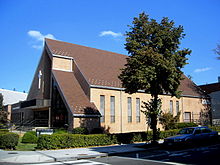- Charlotte Forten Grimké
-
 Charlotte Forten Grimké
Charlotte Forten Grimké
Charlotte Louise[citation needed] Bridges Forten Grimké (August 17, 1837 – July 23, 1914) was an African-American anti-slavery activist, poet, and educator.
Biography
Forten was born in Philadelphia, Pennsylvania to Mary Woods and Robert Bridges Forten, members of the prominent black Forten-Purvis families of Philadelphia. Robert Forten and his brother-in-law Robert Purvis were abolitionists and members of the Philadelphia Vigilant Committee, an anti-slavery network that rendered assistance to escaped slaves. Forten's paternal aunt Margaretta Forten worked in the Philadelphia Female Anti-Slavery Society along with her sisters Harriet Forten Purvis and Sarah Louisa Forten Purvis. Forten's grandparents were Philadelphia abolitionists James Forten, Sr. and his wife Charlotte Vandine Forten, who were also active in the Philadelphia Female Anti-Slavery Society.
In 1854, Forten attended the Higginson Grammar School in Salem, Massachusetts. She was the only non-white student in a class of 200. Known for emphasis in critical thinking, the school focused classes on history, geography, drawing and cartography. After Higginson, Forten studied literature and teaching at the Salem Normal School. Forten cited William Shakespeare, John Milton, Margaret Fuller and William Wordsworth as some of her favorite authors.
Forten became a member of the Salem Female Anti-Slavery Society, where she was involved in coalition building and money-raising. She proved to be influential as an activist and leader on civil rights. She occasionally spoke to public groups on abolitionist issues. In addition, she arranged for lectures by prominent speakers and writers, including Ralph Waldo Emerson and Senator Charles Sumner. Forten was acquainted with many other anti-slavery proponents, including William Lloyd Garrison, editor of The Liberator, and the orators and activists Wendell Phillips, Maria Weston Chapman and William Wells Brown.
In 1856, finances forced Forten to take a teaching position at Epes Grammar School in Salem. She was well received as a teacher but returned to Philadelphia after two years due to tuberculosis. At this point, Forten began writing poetry, much of which was activist in theme. Her work was published in The Liberator and Anglo African magazines.
Forten was the first black teacher to join the American Civil War's Sea Islands mission. During her time in South Carolina, she worked with many former slaves who were enthusiastic about her teaching. She chronicled this time in her essays titled, "Life on the Sea Islands", which were published in the Atlantic Monthly in the May and June issues of 1864. Forten struck up a deep friendship with Robert Gould Shaw, the Commander of the all black 54th Massachusetts Regiment during the Sea Islands Campaign and was present when the 54th stormed Fort Wagner on the night of July 18, 1863. Shaw was killed in the battle and Forten volunteered as a nurse to the surviving members of the 54th. In the late 1860s, Forten worked for the U.S. Treasury Department in Washington, DC recruiting teachers. In 1873 she became a clerk at the Treasury Department.
In December 1878, when Forten was 41, she married Presbyterian minister Francis J. Grimké, the nephew of abolitionists Sarah and Angelina Grimké. Francis J. Grimké was also the brother of Archibald Grimké, who served as U.S. consul in the Dominican Republic from 1894-1898. While her father served in the Dominican Republic, Angelina Grimké lived with Charlotte and Francis Grimke. Angelina Weld Grimké later became an author in her own right.
In 1880, Charlotte and Francis Grimké's daughter Theodora Cornelia was born. She died as an infant.
Charlotte Forten Grimké helped her husband in his ministry at the Fifteenth Street Presbyterian Church in Washington, D.C., organized a women's missionary group, and continued her "racial uplift" efforts.
Charlotte Forten Grimké's last literary effort was in response to an Evangelist editorial, "Relations of Blacks and Whites: Is There a Color Line in New England?" It asserted that blacks were not discriminated against in New England society. Forten Grimké stated that black Americans achieved success over extraordinary social odds, and they simply wanted fair and respectful treatment.
Charlotte Forten Grimké was a regular journal writer until she returned north after teaching in South Carolina. After her return, her entries were less frequent. While she did write about her daughter's death and her busy life with her husband, her writing was less frequent than the daily entries she made when younger. Her diary is one of the few extant documents detailing the life of a free black female in the antebellum North.
The Charlotte Forten Grimke House in Washington D.C. is listed on the National Register of Historic Places.
References
- Randall, Willard Sterne and Nahra, Nancy. "Forgotten Americans: Footnote Figures who Changed American History." Perseus Books Group, United States, 1998. ISBN 0-7382-0150-2.
- Shockley, Ann Allen, Afro-American Women Writers 1746-1933: An Anthology and Critical Guide, New Haven, Connecticut: Meridian Books, 1989. ISBN 0452009812
External links
Categories:- 1837 births
- 1914 deaths
- People from Philadelphia, Pennsylvania
- American abolitionists
- American essayists
- American diarists
- American poets
- African American writers
- Pennsylvania political activists
- African American female writers
Wikimedia Foundation. 2010.


